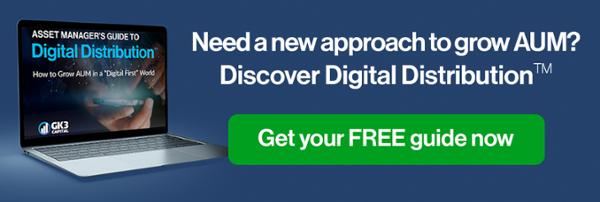
Most sales and marketing teams work like a fast food drive through window, passing materials between the groups with as little contact as possible.
Digital wholesaling requires a different mindset. Growing a business and raising capital in today's digital world requires alignment of your marketing and sales teams. Implementing a Digital Wholesaling Strategy encourages that alignment.
It is about facilitating a memorable client experience and that requires a mix of learning, training, testing, optimization, and most importantly, trust. This article explores the steps marketing and sales teams must take to become true partners while moving beyond the roles that have traditionally defined the relationship.
Asking questions and listening
In a previous post, we discussed Digital Wholesaling with a Winning Inbound Strategy which focused on putting yourself in the shoes of your clients to understand how you can solve their problems. A similar process can help marketing and sales teams join forces.
Marketing can start by listening to the sales team explain how they approach new leads, which topics resonate, what questions and objections they are hearing from their leads, and what points they highlight about themselves. Sales can expand on why it steers conversations in certain directions, which marketing materials provide the biggest benefit, and what materials they avoid and why.
Regular meetings between the teams will help individuals get to know each other and build camaraderie, which will help the teams understand each other’s strengths. From there, they will be able to develop shared goals around items such the number of qualified leads generated and overall conversion rate. The teams can collaborate on blog posts and white papers that drive website visits and align with sales initiatives.
Define updated roles, responsibility and process
Creating a cohesive team involves moving marketing beyond creating static websites and brochures with basic product information and moving sales beyond calling prospects who are not yet qualified. This new world involves having a strong infrastructure with the five things every asset manager needs to meet its sales goals including a Customer Relationship Management system (CRM) with accurate data and a website that attracts and identifies new prospects.
Once the foundation is in place, marketing must develop content that facilitates action and assesses the actions or combination of actions that result in a prospect essentially asking to speak with sales. Ideally, sales should follow up with new qualified leads immediately to capitalize on the action still being top of mind with the new prospect.
Marketing and sales should partner on training sessions so marketing can demonstrate how the activities of prospects on the website are captured in the CRM, what content is featured in automated emails, how the sales team will be alerted when a new qualified lead is generated, and what talking points are most effective in follow-up conversations. Marketing can create reference guides to avoid ambiguity in the process until it becomes second nature for the sales team and to help onboard new colleagues.
Putting your new program into action
Having alignment on how sales and marketing will work together is one thing. Having data about how it operates in the real world will take things to the next level.
Two weeks after launching, and again at 30 days, and at least once each month after that, marketing and sales should meet to review results, gather feedback, and identify opportunities. Marketing should share reports on how many qualified leads were generated, which content programs drove the new leads, and how many meetings sales conducted based on those leads.
Sales should provide feedback about the quality of the new leads and whether the sentiment of the resulting conversations was positive, negative, or neutral.
Having a forum for open and honest dialogue will give the sales and marketing teams confidence that they are aligned in the long-term success of the digital wholesaling program.
Optimizing digital wholesaling over time
Based on data, both sides should be able to share ideas on how to improve the results. That may involve creating new content, developing different talking points as part of the follow-up, capturing additional information in the lead form, or making the lead qualification process more stringent.
The sales and marketing teams should agree on priorities for improvements and create a shared roadmap so there is transparency for where the firm’s digital wholesaling program is heading.
As new initiatives are completed, the reporting and sharing should continue. Did the changes work as expected or were new insights uncovered that could affect future projects? Unlike corporate brochures and static websites of the past that had few changes over time, a digital wholesaling mindset requires constant data analysis, testing new theories, collaboration, and trust. It’s a formula firms can use to get better together every single day.
John Gulino is the Founder and CEO of GK3 Capital LLC. Experienced in all facets of distribution including management, direct sales, training, and development, John has been fortunate to represent some of the industry’s most respected and innovative financial institutions and has consulted with many more of the top asset management firms in the industry on how to better align their sales and marketing efforts.
Topics:


